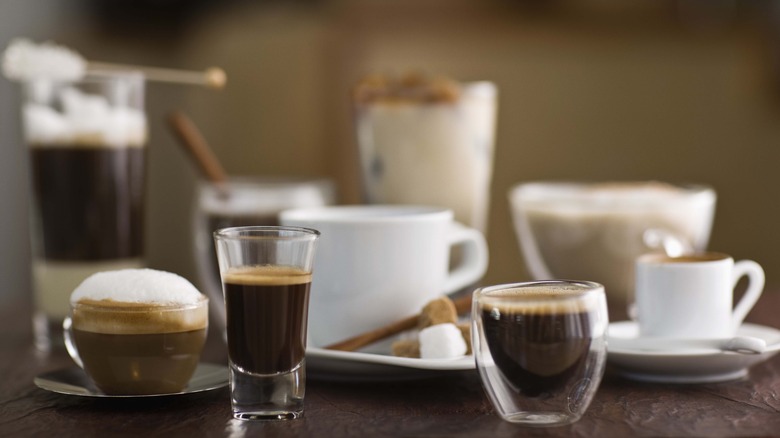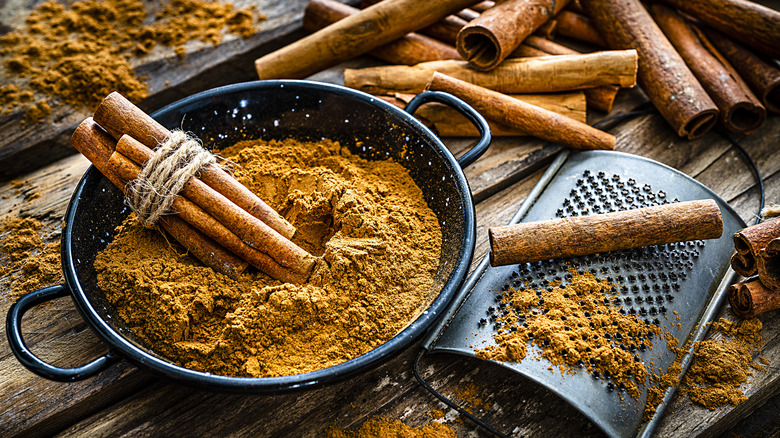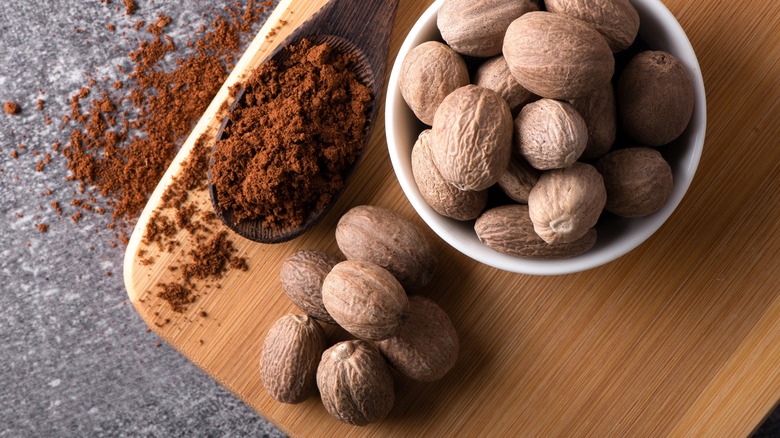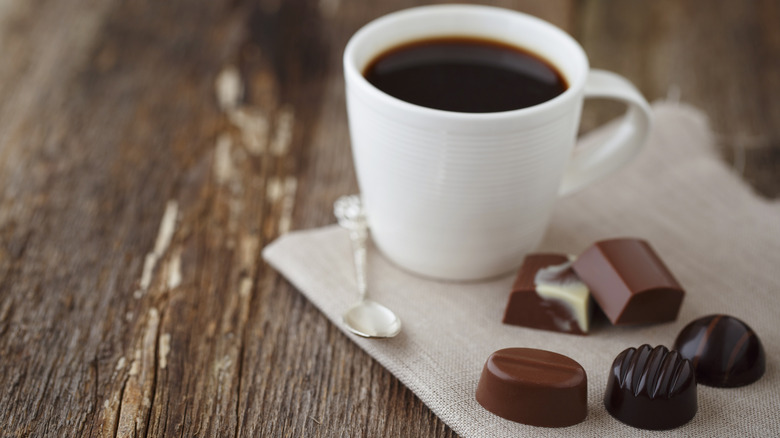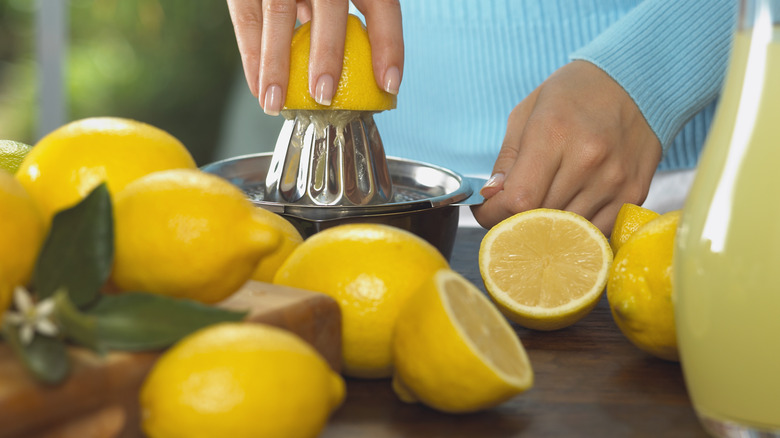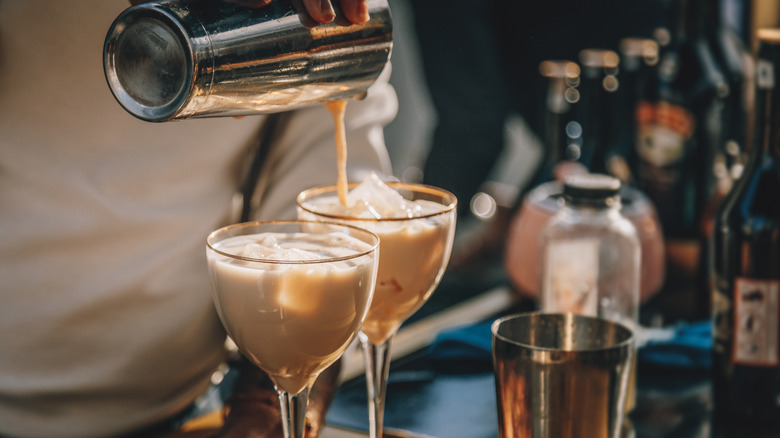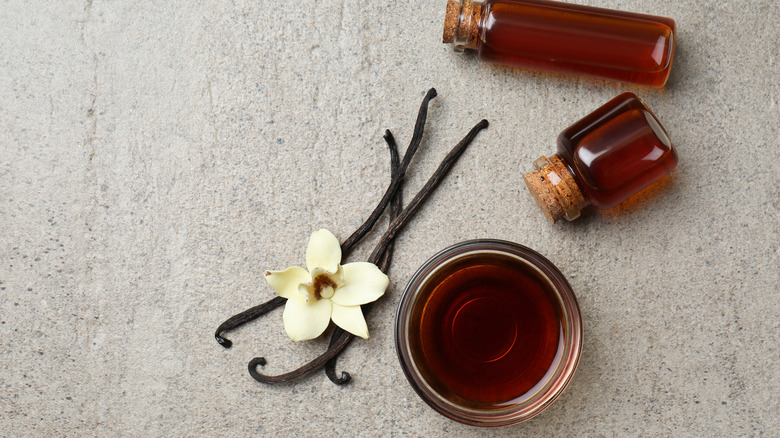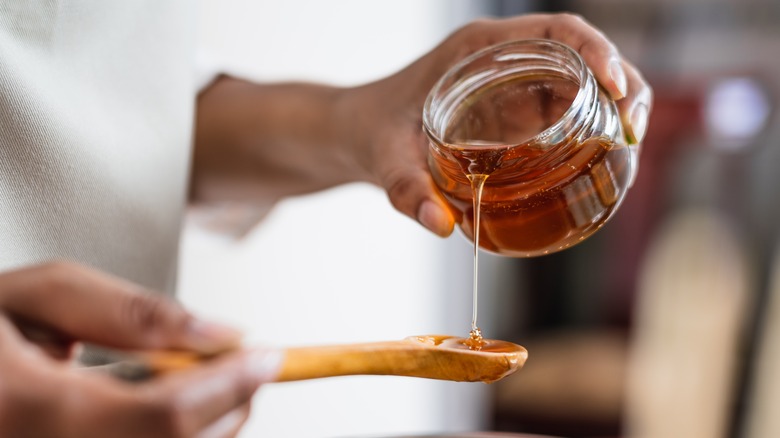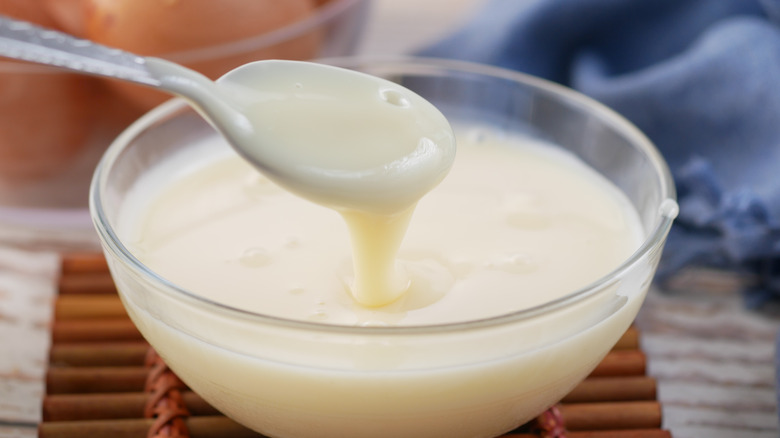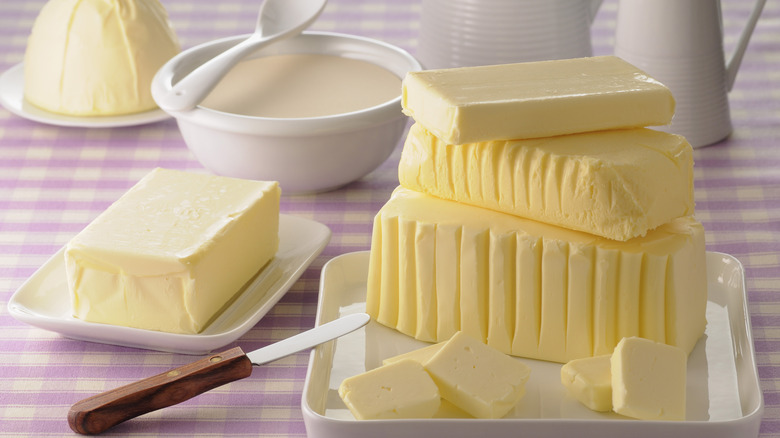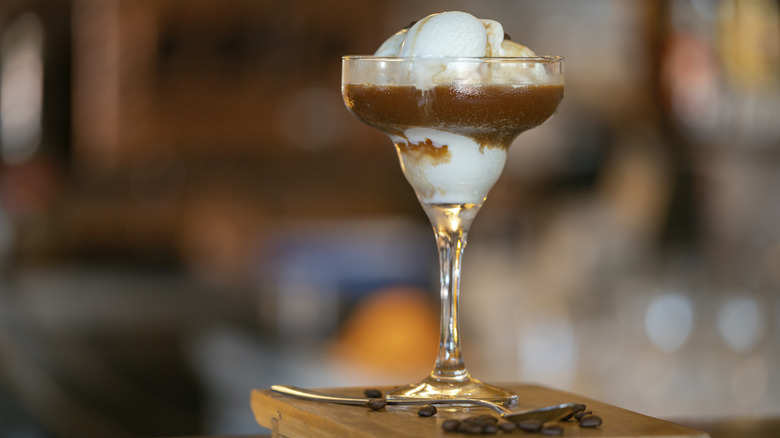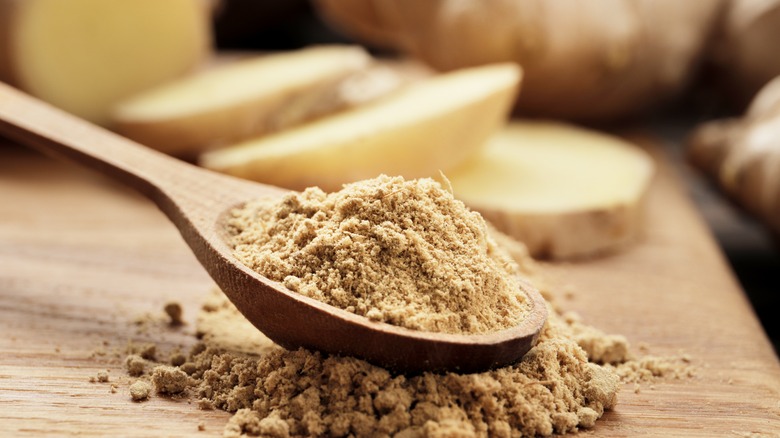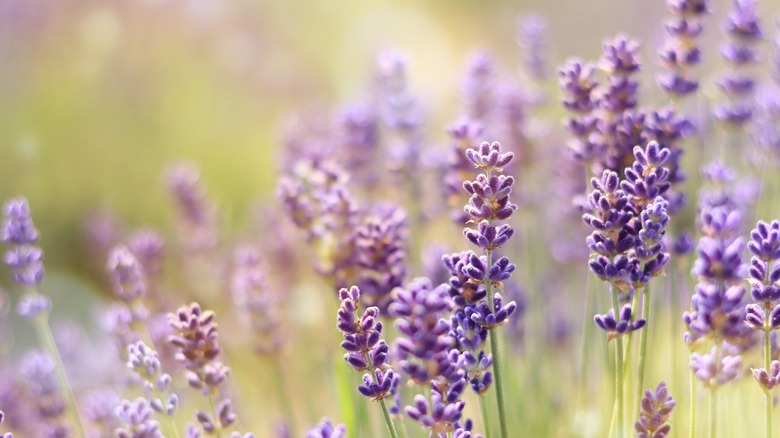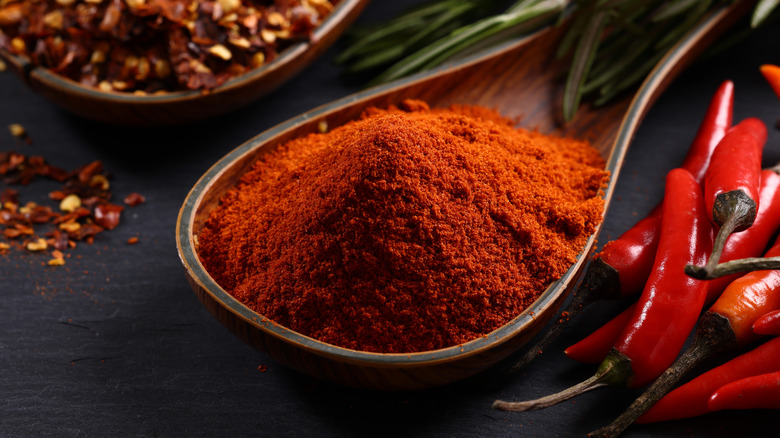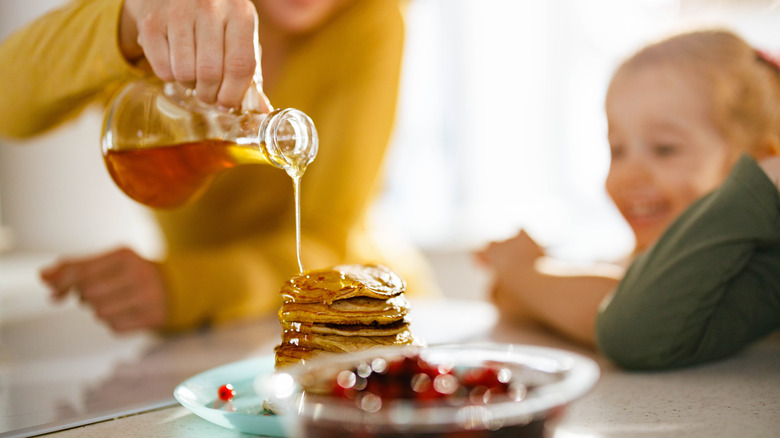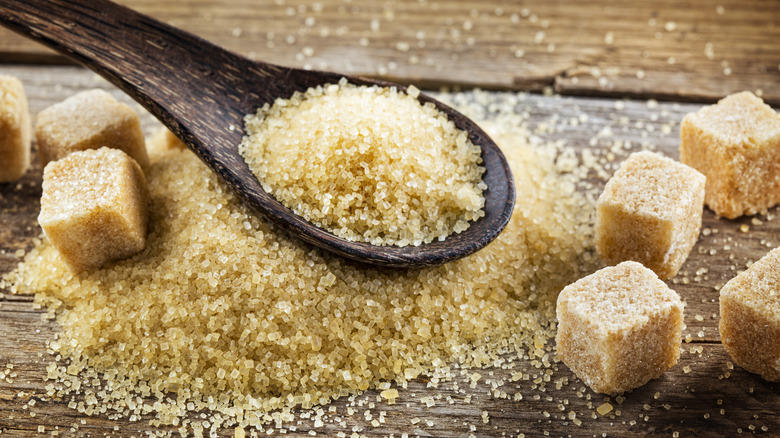15 Additions That Will Give Your Coffee A Flavor Boost
There's nothing quite like the taste and experience of a great cup of coffee. The feeling of that heady aroma wafting into your nose is a unique experience that can change based on the type of beans you choose that morning or how you brew your coffee. Much like a fine wine, a variety of notes may hit you — hints of caramel, chocolate, dark berries, honey, almond, and so much more coat your palette on your first sip and continue as you finish your cup. It's the perfect way to start your day because your coffee is always made exactly the way you want it.
That's the beauty of coffee. Because it's such a customizable drink with endless blends, brews, and methods to make it available at your fingertips, you can explore infinite flavor options or spend your time perfecting your favorite. But beyond the coffee itself, there are also a variety of flavor additives to try that can take your coffee to the next level. Whether you're looking to sweeten your coffee up, try a special type of creamer, or add a hint of zing that brews right into your java, there are many options at your disposal. Not sure where to start? Experiment with some of these ideas and see how you can make your morning cup that much more unique.
Cinnamon
Cinnamon is so much more than a tasty addition to your morning oatmeal recipe or the star of your fall baking dishes; it can also be a warm, spicy addition to your coffee. It's mostly known as a nice topper for your foamy latte or cappuccino, but it also has potential beyond that as a fundamental flavor ingredient in your brew.
Cinnamon in coffee is not a novel idea either — in Mexico, cafe de olla, or coffee made in a clay pot, has been enjoyed for many generations and typically includes cinnamon, unrefined cane sugar, and other spices like cloves. But if you don't have a clay pot to make this traditional recipe, try a simpler alternative: Add a sprinkle of cinnamon to the grounds of your coffee before you brew it, then allow your coffee to brew as normal. Once it's finished, you'll find that the hint of cinnamon adds a warm richness, as well as a natural sweetness that comes without the need for additional sugar.
Nutmeg
Nutmeg is a surprisingly versatile spice. It can find its home in a delicious, seasonal eggnog just as comfortably as it can elevate the richness of a bechamel. Another excellent place to sprinkle a bit of this beloved fall spice? Your coffee, of course.
Much like cinnamon, nutmeg can elevate the flavor notes already in your coffee while adding warmth and spiciness. If you're craving a bit of fall comfort, even outside the autumnal months, then nutmeg can make an excellent coffee additive. Similarly to what you'd do with cinnamon, sprinkle a bit of nutmeg into your ground beans before you brew your coffee. If you really want to get fancy, take fresh nutmeg and grate it into your coffee beans directly. From there, brew with your selected method, and enjoy your coffee. Kick it up a few notches further by mixing nutmeg with other fall spices like cinnamon, cardamom, or allspice for the perfect rival to a pumpkin spice latte.
Chocolate
Chocolate and coffee are a match made in heaven. Both bring out the best in each other and can increase the dark, flavor complexities inherent in each. Because your favorite blend of coffee might already have notes of chocolate in it, why not bring out that chocolatey flavor profile more with actual chocolate? There are a few ways you can do it, too.
The easiest and most common way to add chocolate to your coffee is to grab some cocoa powder and sprinkle it into your coffee grounds to integrate its flavors into your brew. Or, you can sprinkle a bit on top of frothed milk to enjoy the flavor. There's even reason to believe that adding cocoa powder to your coffee can increase your coffee's health benefits. Because cocoa powder and coffee have anti-inflammatory properties, combining both can relax blood pressure and benefit your heart health.
The second method of adding chocolate to your coffee may not be healthy, but it is incredibly indulgent. While brewing coffee or espresso, place a chocolate bar at the bottom of your cup so the hot coffee melts as the coffee pours down on it. This will create a dessert-level drink on par with the richest hot chocolate you've ever tasted.
Lemon
You may have heard of lemon in tea, but have you ever thought of adding lemon to your morning coffee? While it's not for everyone, if you enjoy a citrusy zing in the morning or want to enhance some of the citrus properties of your favorite blend, it's worth a try.
First and foremost, there may be some health benefits to adding a squeeze of lemon to your java. Lemons are rich in vitamin C, which is known to help keep your immune system healthy. Like coffee, lemons also have antioxidants, which can help rid your body of damaging free radicals and reduce overall inflammation. Second, lemon in coffee can add a unique citrus kick that especially complements iced coffee varieties. Take the Italian Shakerato, for example. Made from sugar, espresso, and ice that is shaken up like a cocktail, some Shakerato recipes will also feature lemon to enhance the espresso's natural flavor. It's the perfect kick of caffeine that will also keep you cool in the summer.
Alcohol
In the competition for best pairing with coffee, alcohol tends to edge out chocolate, but only just. That's because there are a variety of alcohols and liqueurs that are actually made to be paired with coffee, as well as many rich cultural traditions of adding different types of liquor to coffee that you can be inspired by.
Irish Coffee is quite possibly the most popular and well-known coffee and alcohol pairing. While the perfect Irish Coffee recipe is hotly debated, there is one certainty across the map — good Irish whiskey is needed to round off the drink.
Beyond Irish Coffee, there are a variety of liqueurs made specifically to drink with coffee. Bailey's, for example, can be a creamy, boozy replacement for milk. Kahlua is also a liqueur made from both rum and coffee beans and goes nicely with chilled coffee drinks.
The Italians have their own variety of coffee with alcohol, known as "caffè corretto." Coffee is seen as finally being "corrected" when a shot of alcohol has been added. The type of alcohol can run the gamut, too, with the most popular typically being grappa or sambuca.
Vanilla Extract
If you're a baker, chances are you already have vanilla extract lying around in your pantry. It's played an integral role in almost all of your goodies, but have you considered what it can do for your beverages? Vanilla extract is an excellent sweetening alternative that adds creaminess and a slight woodsiness without the need for refined sugar.
For a vanilla latte-style drink you can make at home, take a few drops of your vanilla extract and add it to your coffee grounds before you brew it. You'll get a good amount of vanilla flavor if you brew your coffee with a French press and allow it to steep for a while. Be careful not to add too much extract, because vanilla extract can be strong and quickly become overpowering. To kick up the flavor, add a few drops of vanilla to steamed milk, and add that to your coffee as well.
If you really want to take your vanilla coffee to the next level, you can experiment with adding vanilla beans directly to your coffee grounds. The sky's the limit.
Honey
For some added sweetness that won't impact the overall taste of your coffee too much, honey is an excellent option. Honey is a well-known alternative to refined sugars for good reason — though it contains mostly sugar itself, honey also has added vitamins, minerals, and antioxidants that can work with the antioxidants in your coffee to reduce inflammation and repair damage to your cells.
Different varieties of honey will also carry different levels of flavor that can be added to your coffee. If all you want is a bit of sweetness, opt for clover honey which has the mildest flavor and happens to be the most commonly sold honey in the U.S. To experiment a bit with your sweetener, try manuka or buckwheat honey which come with a stronger flavor. Like with tea, honey will dissolve into hot coffee once it's added and then mixed. To start, try adding 2 teaspoons of honey to your coffee and evaluate if the sweetness is to your liking.
Condensed Milk
If you don't already have condensed milk waiting for you in your pantry, take this as a sign to make it a staple. Condensed milk is an incredibly versatile ingredient and can be used in a range of dishes from baked goods to cold desserts like ice cream. The quickest way, however, to get its sweet, creamy flavor benefits is to add condensed milk to your coffee.
In many Southeast Asian cultures, condensed milk and coffee are synonymous. Vietnamese Coffee, for example, is a popular iced drink that combines the sweetness of condensed milk with the robust notes of dark-roasted coffee and sometimes adds spices like cloves, chicory, and cardamom. You'll find similar types of coffee in Cambodia as well as the Philippines.
Because condensed milk is an American invention, you'll have no trouble finding it at your local grocery store to add to your coffee rotation. While it makes an excellent creamer substitute for iced coffee, condensed milk can also be added to hot coffee for a punch of sweetness.
Butter
Believe it or not, butter is having a moment as a coffee additive, both for its flavor and potential health benefits. If you've ever heard of Bulletproof coffee, then you're likely already familiar with this trend. It's believed by some that adding butter or similar ingredients high in triglycerides, a specific type of fat, can come with a host of health benefits. While there still needs to be more research done, proponents of adding butter to your coffee believe it can help keep you fuller for longer, while also promoting mental clarity and increased energy.
Contested health benefits aside, adding butter to coffee makes for a surprisingly creamy and delicious drink. If you want to turn your morning cup into more of a meal that can keep you full up until lunch, add 1 or 2 tablespoons of unsalted butter alongside one or 2 tablespoons of coconut oil or MCT oil to your coffee, then mix the ingredients together in the blender. You'll end up with a smoothie-like drink that's unlike any coffee you've had before.
Ice Cream
Leave it to the Italians to know how to take a simple drink like espresso and make it an incredibly appetizing dessert. While the variety of ways Italians drink their coffee can be a list of its own, let's put a spotlight on one of the most decadent options — affogato.
Affogato, which translates as "to drown," is an incredibly easy dessert-beverage combo to make at home. Though there is still debate on how to make the perfect, traditional affogato (can you stray beyond vanilla gelato?) or when the affogato was first invented (was it the 17th century of the 1950s?), the overall recipe is easy enough. Place a few scoops of your favorite ice cream in a bowl, then drown that ice cream with freshly brewed espresso. Do not let the espresso cool down, however — the strong, bitter coffee is meant to stay hot to create a stark flavor contrast with the cold, sweetness of the ice cream. Eventually, the ice cream will melt, leaving you with a creamy, shake-like dessert that offers a serious caffeine kick. Tiramisu, who?
Ginger
Craving some spice that also adds a touch of heat and a host of health benefits? Look no further than ginger as your newest go-to coffee additive. Ginger is packed with antioxidants, much like coffee, which means combining the two makes for a seriously powerful anti-inflammatory that may also help with your digestion. Like other spices on this list, you can start experimenting with ginger by adding about 1 teaspoon of ground ginger to your coffee beans and brewing it that way, or stirring ground ginger into your coffee once it's brewed.
Freshly grated ginger root added to your morning brew is also a great option for a more impactful flavor with greater potential health benefits. For a bit of cultural exploration, you can even try replicating Qishir, a traditional hot drink in Yemen made with spiced coffee husks (the shell of the coffee bean), ginger, and other spices like cinnamon.
Lavender
Who needs to spend their money on Starbucks' latest Lavender Oat Milk Latte when you can bring a touch of spring flavor to your coffee at home? If you're looking to experiment outside of the realm of the ordinary, try this beloved ingredient in your next cup of java. Lavender offers a soft, floral aroma with a light botanical sweetness that's reminiscent of a meadow in the south of France. Lavender is also known for its relaxing properties, which could potentially help to negate the overall jittery effects of coffee with its calming aromas.
To create a barista-quality drink at home, add a splash or two of lavender syrup to your freshly brewed coffee cup and stir it in. Lavender buds can also be added to your coffee grounds for a gentle flavor that won't veer into soap territory. If you want even more botanical goodness, add some of your lavender syrup to frothy milk, and you'll have the perfect Starbucks dupe.
Cayenne Pepper
For a serious spicy kick that'll certainly wake you up in the morning, add a dash of cayenne pepper to your coffee. It's definitely not the most conventional flavor additive on this list, but if you're ready to try something extreme that can potentially accentuate some of the lesser-known notes in your coffee, go ahead and try this one out.
Like coffee and many other items on this list, cayenne pepper has a host of health benefits that you might benefit from if you add it to your coffee. Cayenne pepper contains vitamin A, which is known to help with your immune system, vision, and reproductive system. It also has capsaicin, the chemical element that gives cayenne pepper its kick and is known to help boost the metabolism.
There are a few ways you can experiment with cayenne pepper in your coffee. If you're ready to go all in, try a bit of cayenne pepper in the ground beans of your dark roast. A half a teaspoon is a good place to start, then adjust the spice from there. If you find your coffee to be too spicy, you can always add milk. To push your barista skills a step further, mix your coffee grounds with some cocoa powder and cayenne pepper for a spicy mocha you won't soon forget.
Maple Syrup
Pancakes aren't the only breakfast item that can benefit from a drizzle of maple syrup — the beloved breakfast syrup can also add a bit of fall warmth to your coffee. If you're in a pinch and don't have any sugar or vanilla extract on hand to enhance the flavor of your coffee, a little bit of maple syrup makes for a great substitute.
The easiest way to experiment with maple syrup in your coffee is to add it directly into your warm brew and stir so it dissolves completely. A teaspoon to start can help you gauge sweetness levels and flavor balance. When using maple syrup as your sweetener, you'll find it adds a robust, slightly smoky sweetness to your coffee which can go nicely with a variety of blends. Different types of syrups will offer different flavor profiles to your coffee, so trying out a variety of syrups with various blends is a good way to further customize your morning coffee.
Brown Sugar
Whether you're a baker who always has a bit of brown sugar on hand or prefer sugar as the only sweetener you add to your coffee, brown sugar makes for the perfect flavor additive. Unlike traditional refined sugar, brown sugar contains molasses, which impacts the overall richness and depth of flavor of your coffee. You'll find that adding brown sugar to coffee adds a darkness with notes of caramel that emboldens your brew, so much so that you might not even need to add much creamer.
To further customize your coffee, you can sample different types of brown sugar with your drink. Dark brown sugar will add a more molasses-forward flavor that can really complement darker roast coffees. Light brown sugar is also lighter in flavor, helping it to balance well in blond roasts or integrate more seamlessly into coffee without impacting the flavor of your blend too drastically. Whatever you decide, brown sugar is an easy flavor additive that can elevate your coffee.
